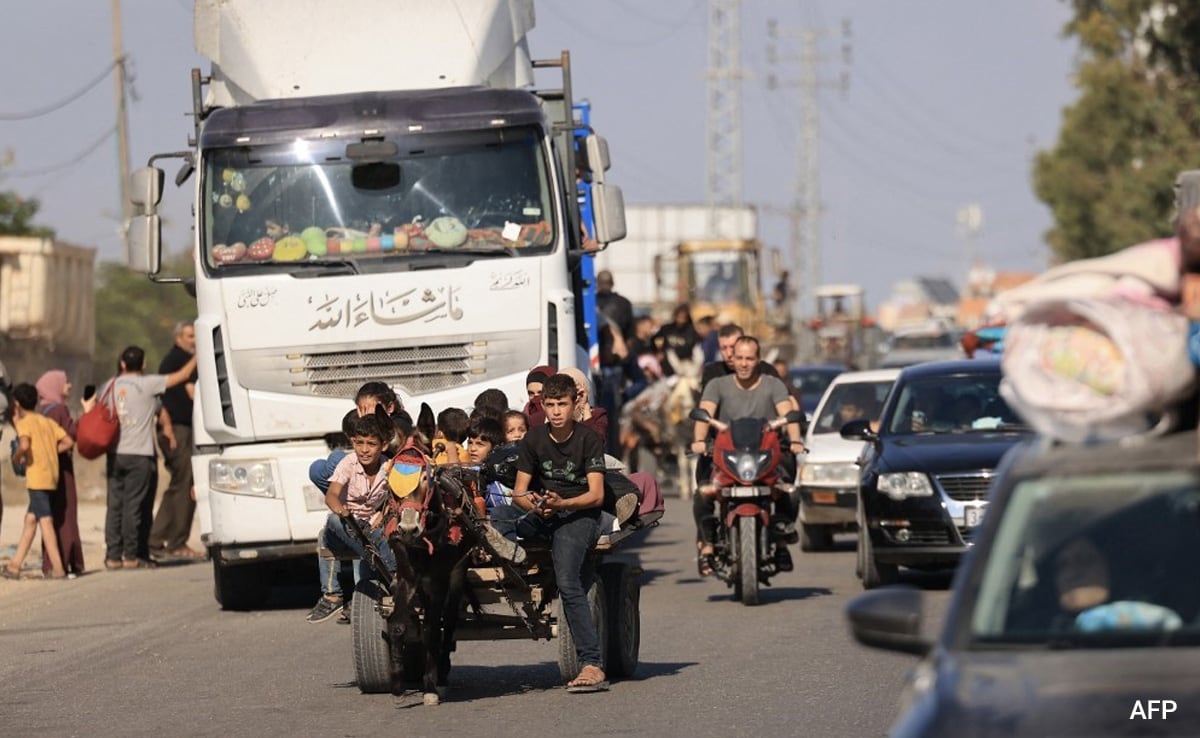A balloon carrying various objects including what appeared to be trash, believed to have been sent by North Korea, is pictured at the sea off Incheon, South Korea, June 9, 2024.
| Photo Credit: VIA REUTERS
What’s been happening
The current “balloon war” isn’t a new conflict, but an escalation of a long-standing propaganda tactic between North and South Korea. A timeline
- May 2024: South Korean activists affiliated with “Fighters for Free North Korea” appear to have initiated the recent escalation. It all started with these activists sending around 10 balloons carrying leaflets critical of the North Korean regime and USB drives containing South Korean media (K-pop, dramas) across the border. This wasn’t new, but surely was the tipping point.
- Late May 2024: North Korea retaliated by sending hundreds of balloons laden with trash and possibly even manure into South Korea. This was likely intended to be a nuisance and show of defiance. The first set of balloon attacks involved around 250 balloons. The second wave, launched within 15 days of the first, consisted of approximately 300 balloons, with 80 landing in South Korea.
- Early June 2024: Tensions rose further as North Korea launched another wave of trash-filled balloons. South Korea responded by resuming loudspeaker broadcasts with news and information critical of the North Korean government, a tactic used in the past. This happened for the first time since 2018.
- Mid-June 2024: Kim Yo-jong, the influential sister of North Korean leader Kim Jong-un, condemns the South’s actions, calling them a “prelude to a very dangerous situation.” South Korea views this as an escalation in threats.

FILE – This photo provided by South Korea Defense Ministry, shows balloons with trash presumably sent by North Korea, in South Chungcheong Province, South Korea, on May 29, 2024. South Korea has recently retaliated for North Korea’s trash-carrying balloon launches with propaganda loudspeaker broadcasts at border areas. The South Korean broadcasts reportedly included K-pop sensation BTS’s mega hits like “Butter” and “Dynamite,” weather forecasts and news on Samsung as well as outside criticism on the North’s missile program.(South Korea Defense Ministry via AP, File)
These balloons are large, clear cylinders filled with helium and carry messages written in Korean.
This balloon exchange is happening against the backdrop of a larger issue: North Korea’s nuclear program and the stalled diplomatic efforts to address it.
The balloon war itself isn’t particularly dangerous (except for the environmental impact of the trash), but it highlights the fragile relationship between the two Koreas and the potential for a more serious conflict.
This “balloon war” is part of a long history of psychological warfare between the two Koreas.

FILE – Park Sang-hak, center, a refugee from the North who runs the group Fighters for a Free North Korea from a small Seoul office, and South Korean conservative activists prepare to release balloons bearing leaflets condemning the North Korean leader during an anti-North Korea rally against the 99th anniversary of Kim Il Sung’s birth, called “The Day of the Sun,” at the Imjingak Pavilion near the border village of Panmunjom in Paju, South Korea, on April 15, 2011. The balloons read “Overthrow Kim Jong Il’s dictatorship.” South Koreans were alert Friday, June 7, 2024 for possible new launches by North Korea of balloons carrying rubbish into the South, a day after Seoul activists flew their own balloons to scatter political leaflets in the North. (AP Photo/Lee Jin-man, File)
| Photo Credit:
Lee Jin-man
History: What’s up with the Koreans?
The division of the Korean Peninsula dates back to the end of World War II in 1945 when Korea was liberated from Japanese occupation. The peninsula was split along the 38th parallel, with the Soviet Union occupying the North and the United States occupying the South. This division was meant to be temporary, but ideological differences led to the establishment of two separate governments: the communist Democratic People’s Republic of Korea (North Korea) and the capitalist Republic of Korea (South Korea).
In 1950, the Korean War erupted when North Korean forces invaded the South. The conflict lasted until 1953, ending in an armistice but not a peace treaty, technically leaving the two Koreas still at war. Since then, the peninsula has been marked by intermittent periods of hostility and efforts at reconciliation, with ongoing tensions stemming from ideological differences, military confrontations, and North Korea’s nuclear ambitions.

A leaflet (R) containing a US dollar bill is seen next to a poster (L) reading “Republic of Korea loves the North Korean people” during an AFP interview with North Korean defector Park Sang-hak in Seoul on June 25, 2024. Park considers the propaganda balloons he floats into his homeland to be part of a tradition of psychological warfare, and vows to keep going until Kim Jong Un’s regime falls. The son of a North Korean double agent who escaped his country in 1999, Park has been sending balloons loaded with anti-regime propaganda leaflets, US dollar bills and USB drives of K-pop across the border for nearly 20 years. (Photo by Anthony WALLACE / AFP) / To go with ‘SKOREA-NKOREA-DIPLOMACY-CONFLICT, PROFILE’ by Kang Jin-kyu and Cat Barton
| Photo Credit:
ANTHONY WALLACE
Use of balloons in psychological warfare
The use of balloons for psychological warfare dates back to the Korean War (1950-1953).
- Korean War: The United Nations and South Korean forces used balloons to drop millions of leaflets over North Korean and Chinese troops. These leaflets contained messages encouraging defection and spreading news about the progress of the war.
- Cold War: The United States and South Korea continued to use balloons to send anti-communist propaganda into North Korea. Balloons were loaded with leaflets, radios, and other items intended to influence North Korean civilians and military personnel.
How a psychological impact
These balloons could reach remote and heavily guarded areas that were otherwise inaccessible, spreading propaganda deep into enemy territory. Leaflets and broadcasts from the outside world could undermine the enemy’s morale and sow doubt among the population about their government and its propaganda.
A balloon containing leaflets denouncing North Korean leader Kim Jong Un is seen near the demilitarized zone separating the two Koreas in Paju, South Korea, March 26, 2016, on the sixth anniversary of the sunken naval ship Cheonan. The lettering on the banner reads “Merciless attacks on nuclear addict Kim Jong Un” (top) and “Sprits of deceased 46 navy sailors on the sunken naval ship Cheonan want Kim Jong Un’s life.” (bottom). REUTERS/Kim Hong-Ji
| Photo Credit:
KIM HONG-JI
‘Smart balloons’
A group in Seoul called “The Committee for Reform and Opening up of Joson” has come up with a new way to send messages to North Korea. They’ve built high-tech balloons they call “smart balloons.” These balloons can fly far into North Korea and drop leaflets or even play messages with speakers. This is a whole new level of using balloons to try to influence North Korea. Let’s see how these balloons work and what kind of messages they carry.
A monitor shows the GPS tracking of balloons built by a Seoul-based activist group that are designed to distribute anti-North Korean messages over North Korean territory in Seoul, South Korea, June 3, 2024. REUTERS/Kim Hong-Ji
| Photo Credit:
KIM HONG-JI
Fast facts
These custom-made balloons utilise 3D-printed parts and components sourced online.
Each balloon costs around $1,000. (83 thousand INR appx)
Payload capacity: Up to 7.5 kilograms of leaflets, speakers, or a combination of both.
Leaflet dispensers: Programmed to scatter leaflets at intervals based on weather conditions.
Speakers with parachutes: These waterproof devices blare pre-recorded messages critical of North Korea’s leader for up to 5 days.
A member of a Seoul-based activist group, who is a North Korean defector, sets the time on a device that will be carried by balloon to distribute anti-North Korean leaflets over North Korean territory, in Seoul, South Korea, June 3, 2024. REUTERS/Kim Hong-Ji
| Photo Credit:
KIM HONG-JI
Pre-programmed to scatter 1,500 leaflets, 25 at a time.
Designed to account for flight path, wind, and other weather conditions.
Deploy with parachutes that open mid-flight.
Broadcast 15 minutes of pre-recorded messages in a North Korean accent, pausing for 30 minutes between sessions.
Battery life: up to 5 days.
A test run for a speaker device attached to parachutes which will broadcast anti-North Korean messages after being carried over North Korean territory by balloon, in Seoul, South Korea, June 3, 2024. REUTERS/Kim Hong-Ji
| Photo Credit:
KIM HONG-JI
In 2020, the South Korean government banned the launches, citing concerns about escalating tensions with the North. However, a court later overturned the ban, upholding freedom of speech. Some South Koreans oppose the balloon launches, fearing they provoke North Korea and endanger local residents. This legal ambiguity, coupled with public fear of retaliation and North Korean threats, creates a contentious environment around the balloon campaigns.














